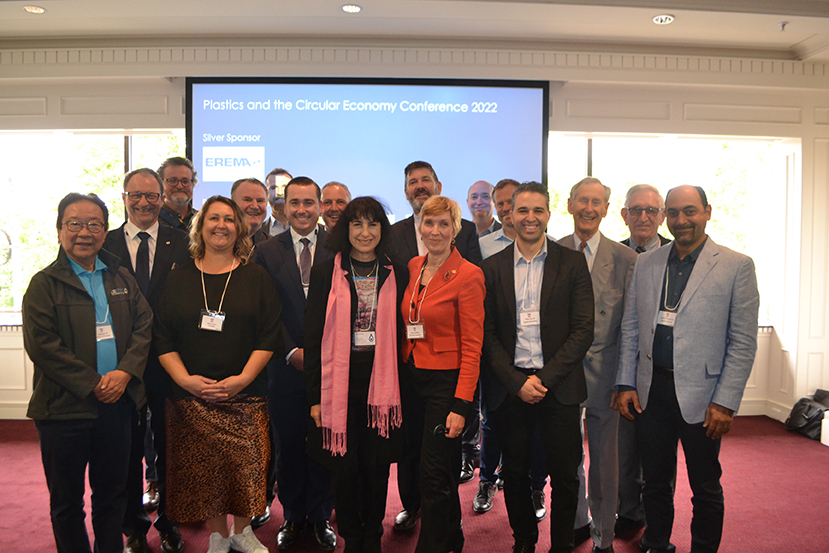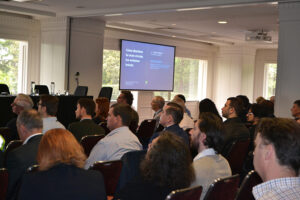Thunder From Down Under: Circular Economy Is Hot Topic in Australia

SPE chapter conference issues communique of priorities for industry growth in Australia
Attendees at a conference in Australia boldly called for a set of improvements to prevent the loss of the vital plastics industry in Australia, and to ensure plastic pollution and recycling targets are reached.
The first conference in Australia to focus on a circular, low-emissions future for plastics took place in Melbourne, Nov. 22 to 23. The Plastics and the Circular Economy Conference was coordinated by the Australian-New Zealand chapter of SPE. The 150 attendees represented senior decision makers in government, industry and environmental organizations, manufacturers, recyclers and brands from across Australia and New Zealand, as well as Asia and Europe.

The conference was almost a standing room only event, with 150 in attendance.
The challenges and priorities for success in the Australian plastics industry dominated the presentations and discussions. Attendees were motivated to take the unusual step of preparing, discussing and releasing the following communique. Their view was that Australia is at a fork in the road and will either attract billion-dollar global investment for a shift to become an efficient circular plastics economy or will lose vital manufacturing capacity and competitive advantage.
The following statements reflect the general view and mood of conference participants.
- Attendees endorsed the Australian government’s Climate Change and National Waste Action Plan targets of zero carbon emissions by 2050 and 80 percent resource recovery by 2030. Attendees were deeply engaged in the implications of global carbon and plastic pollution treaties and trade requirements for Australia.
- Attendees expressed concern over Australia’s ongoing rising emissions, rising plastic pollution, uneconomic recycling of plastics, increasing losses of recyclable materials to landfills and potential collapse of key plastics manufacturing supply chains and capability.
- There is growing frustration at the lack of progress and determination for big vision and concerted action to remove barriers that prevent improvements to the types and fates of plastics allowed and used in Australia.
- There was frustration at “spinning wheels,” namely that the rates for recycling and recycled content in products and packaging in Australia have been static for the last decade and that national 2025 and 2030 targets will fail to be met.
- Attendees called for measures to improve the productivity, efficiency and viability of reuse and recycling of plastic products and packaging in Australia. There was determination that the halt of [recycling] businesses such as REDcycle, of Melbourne, and Envorinex in Tasmania be a turning point, and that plastic recycling reaches rates comparable to competing plastics manufacturing nations like South Korea and France.
- There was determination that actions must be taken to secure the continued operation of Australia’s plastics resins and manufacturing base in order that the company have the hope of achieving recycling, circularity and lower emission targets by 2025 and 2030. It was stated several times that none of these targets will be achieved if improvements are not made to secure Australia’s sovereign manufacturing capacity for plastics. Australia’s vulnerability to supply chain disruptions during the COVID pandemic and the impact of exorbitant gas prices upon manufacturing, especially plastics products and resin feedstock, were frequently cited.
- Australia has made some important investments in recycling infrastructure in recent years, mainly in PET packaging, and over AUD$10 billion (about US$6.86 billion) in investment is feasible and required to hit the 80 percent waste reduction target by 2030. Key CEOs expressed determination to invest at scale should the vision, policies and settings improve and barriers [to growth] be removed.
- Attendees urged government, industry groups and major sectors and supply chains and businesses to collaborate to develop policies, strategies and targets that will reset financial, legal, regulatory, certification and performance standards for plastics products and packaging.
The following measures were proposed by attendees to enable financially viable improvements to eco-design, reuse, repair, recovery and recycling of plastics in Australia, with associated benefits of approximately 40 to 80 percent lower greenhouse gas emissions per metric ton of plastics reused or recycled, reduced pollution and loss of valuable plastic recyclables to landfills.
- Landfill levies upon valuable products and packaging need to double and be brought into line with competing manufacturing nations. Levies currently fail to provide the financial business case to divert good products and material from landfill, and to cover the cost of sorting, reprocessing and remanufacture. Such improvements would lift Australia’s productivity, and help it meet emissions, recycling and waste reduction targets.
- Australia’s voluntary approach to recycled content is weak by international standards. Australia only has voluntary targets for packaging, and no targets for recovery of other plastics products. Phasing in mandatory regulations for recycled content in appropriate products and packaging will result in market pull and an improved business case for better design, collection, sorting and recycling. This can also be achieved through tenders, specifications in priority sectors and industry targets, and mandating industry performance certification and labeling programs that build upon the success of the country’s WEL (water efficiency labeling) and E3 (energy labeling) appliance programs.
- Improving the economics of recycling will result in many major multimillion-dollar investments in both mechanical and advanced (chemical) recycling, benefiting several sectors (packaging and food packaging especially, building, agriculture, transport, infrastructure, clothing and textiles, etc.) and many regions of Australia.
- Australia still has lax import regulations that permit the import of plastics products with harmful chemical additives, as in cheap tires. Such regulations need to be updated in line with other developed nations and to improve environmental outcomes and recycling rates.
- Australia still has a lax voluntary approach allowing non-recyclable products and packaging into the market. The current lack of national regulations results in high waste from households and businesses, and limits the performance and viability of Australian collectors, sorters, manufacturers and recyclers. It also hinders the adoption of high-performance certifications and labeling schemes.
- Australia has a growing plethora of niche voluntary stewardship initiatives that are causing confusion and high cost for some sectors such as agriculture and exhausting well-intentioned people who are trying to create and manage them and recruit members. Attendees urged coordination for unity, efficiency and success. It was also noted that almost all stewardships are functioning as subsidized collection schemes and not improving design, repair or recyclability.
- It was agreed that most stewardship schemes in Australia are narrow in scope and voluntary membership, and that most successful schemes overseas are mandatory. This adds further complexity and burden to Australia’s capability to meet [circular] targets.
In conclusion, the adoption of these financial measures and regulations for quality, higher performance, reuse, repair and recyclability will minimize greenwashing and lift Australia’s productivity, while reducing emissions and waste. These measures will also help Australia’s manufacturers to comply with increasingly stringent import requirements in Europe and Asia concerning low embodied emissions, repairability in design, product recyclability and use of recycled content.
Attendees were enthused and energized by the introduction of these recommendations and welcomed the contribution and collaborative strength of government and industry to unlock Australia’s extraordinary potential and investment [opportunities in plastics]. They were determined that Australia become not only a global renewable energy superpower but also a circular plastics nation.
Prepared on behalf of conference attendees, shared, edited and approved in principle during the concluding plenary session of the conference, Nov. 23, 2022. (The communique has been edited by Plastics Engineering for clarity and space.)
